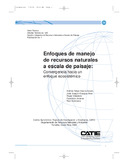| dc.contributor.author | García Azuero, Andrés Felipe | es_ES |
| dc.contributor.author | Campos Arce, José Joaquín | es_ES |
| dc.contributor.author | Villalobos Soto, Róger | es_ES |
| dc.contributor.author | Jiménez Otárola, Francisco | es_ES |
| dc.contributor.author | Solórzano, Raúl | es_ES |
| dc.contributor.other | Departamento de Recursos Naturales y Ambiente | |
| dc.coverage.spatial | Turrialba, Costa Rica | |
| dc.date.accessioned | 2014-10-17T14:55:58Z | |
| dc.date.available | 2014-10-17T14:55:58Z | |
| dc.date.issued | 2005 | es_ES |
| dc.identifier | 367559 | es_ES |
| dc.identifier.isbn | 978-9977-57-405-9 | es_ES |
| dc.identifier.isbn | 9977-57-405-7 | es_ES |
| dc.identifier.uri | https://repositorio.catie.ac.cr/handle/11554/1635 | |
| dc.description.abstract | Desde la Conferencia de Estocolmo sobre Ambiente Humano en 1972, se han desarrolla-do diversas iniciativas y se han adquirido importantes compromisos políticos para alcanzarel desarrollo sostenible. Diferentes iniciativas y enfoques para el manejo de recursos natu-rales son necesarias para asegurar la aplicabilidad del desarrollo sostenible dentro de unamplio rango de condiciones particulares que existen en las regiones del mundo. Sinembargo, a pesar del tiempo y los esfuerzos invertidos aún no se ha logrado avanzar haciael desarrollo sostenible, los principales obstáculos han sido sociales, económicos y políti-cos, pero para solventar los primeros se requiere de voluntad política. De esta forma, elaspecto político se vuelve crucial para alcanzar un desarrollo más armonioso y justo parala humanidad, principalmente para las poblaciones más débiles.Se requiere entonces que las diferentes iniciativas o enfoques que se desarrollen tenganadherencia a conceptos más amplios y con relevancia y respaldo político. Así, el enfoqueecosistémico de la Convención sobre Diversidad Biológica (CDB), desarrollado como unaestrategia para la gestión integrada de los recursos naturales, que promueve la conser-vación y uso sostenible de modo equitativo, y que ha sido recomendado a las Partes de laCDB para su aplicación, surge como una oportunidad para que iniciativas como las reser-vas de biosfera, bosques modelo, áreas de conservación, y manejo integrado de cuencashidrográficas, se vinculen con enfoques mayores y comprometidos internacionalmente.Se analizaron comparativamente diversas iniciativas para identificar los principales ele-mentos que las relacionaran, y posteriormente, a la luz de estos elementos, se analizó surelación con el enfoque ecosistémico. Se concluyó que éstas iniciativas están relacionadascon los principios del enfoque ecosistémico, por lo que éste último puede servir de canalpara desarrollarlas y alcanzar el desarrollo sostenible. | es_ES |
| dc.description.abstract | The Ecosystem Approach and other natural resources management initiativesSince the Conference on Human Environment held in Stockholm on 1972, diverse initiativesand important political commitments have been developed and acquired to reach sustain-able development. These Different initiatives and approaches to natural resource manage-ment are necessary to ensure the applicability of sustainable development considering par-ticular conditions that exists in worlds’ regions. However, in spite of the time and effortsinvested, sustainable development has not progressed; social, economic and politicalissues have been the principal obstacles, but in order to solve the first, political intentionsare required. In this sense, political issues become crucial to reach a more harmonious andfair development to humankind, mainly for weaker populations.Therefore it is required that the different initiatives and approaches developed are linkedwith broader concepts and are relevant and have political support: In this way, the ecosys-tem approach of the Convention on Biological Diversity (CBD), developed as a strategy forintegrated natural resources management that promotes conservation and sustainable usein an equitable way and that has been recommended to the Parties of the CBD for its appli-cation, becomes an opportunity to link initiatives like biosphere reserves, model forests,conservation areas, and integrated watershed management with broader approaches andwith an international commitment.In this way, initiatives were analyzed comparatively in order to identify the principal ele-ments to relate them, after words, an analysis of the relation between these elements andthe ecosystem approach was done. It was concluded that these initiatives are related withthe ecosystem approach principles, so the latter could be the way to develop the initiativesand to reach sustainable development. | en_En |
| dc.description.sponsorship | CATIE - Centro Agronómico Tropical de Investigación y Enseñanza Turrialba, Costa Rica | |
| dc.format.extent | 61 páginas | |
| dc.language.iso | es | es_ES |
| dc.publisher | Centro Agronómico Tropical de Investigación y Enseñanza (CATIE) | es_ES |
| dc.relation.ispartof | Serie Técnica. Informe Técnico | es_ES |
| dc.relation.ispartofseries | Serie Técnica. Informe Técnico, no.340. | |
| dc.subject | RESERVAS NATURALES | es_ES |
| dc.subject | ECOSISTEMA | es_ES |
| dc.subject | CUENCAS HIDROGRAFICAS | es_ES |
| dc.subject | ORDENACION DE CUENCAS | es_ES |
| dc.subject | ORDENACION DE RECURSOS | es_ES |
| dc.subject | SOSTENIBILIDAD | es_ES |
| dc.subject | CONSERVACION DE RECURSOS | es_ES |
| dc.title | Enfoques de manejo de recursos naturales a escala de paisaje: convergencia hacia un enfoque ecosistémico | es_ES |
| dc.type | Libro | es_ES |


